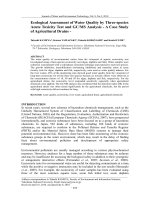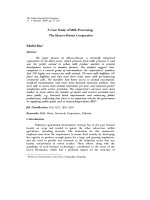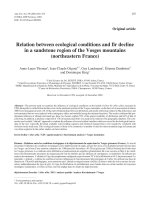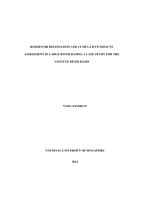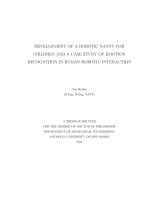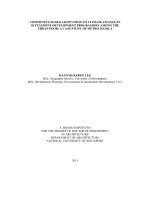The relationship between student motivation and learning achievements from a sociocultural perspective a case study of the police university
Bạn đang xem bản rút gọn của tài liệu. Xem và tải ngay bản đầy đủ của tài liệu tại đây (2.04 MB, 267 trang )
VIETNAM NATIONAL UNIVERSITY
HANOI UNIVERSITY OF LANGUAGES
& INTERNATIONAL STUDIES
LE HUONG HOA
THE RELATIONSHIP BETWEEN STUDENT MOTIVATION
AND LEARNING ACHIEVEMENTS FROM
A SOCIOCULTURAL PERSPECTIVE:
A CASE STUDY OF THE POLICE UNIVERSITY
A THESIS SUBMITTED IN TOTAL FULFILLMENT
OF THE REQUIREMENTS FOR THE DEGREE
OF DOCTOR OF PHILOSOPHY
HANOI- 2015
VIETNAM NATIONAL UNIVERSITY
HANOI UNIVERSITY OF LANGUAGES
& INTERNATIONAL STUDIES
LE HUONG HOA
THE RELATIONSHIP BETWEEN STUDENT MOTIVATION
AND LEARNING ACHIEVEMENTS FROM
A SOCIOCULTURAL PERSPECTIVE:
A CASE STUDY OF THE POLICE UNIVERSITY
(Mối quan hệ giữa động cơ và kết quả học tập của sinh viên dựa trên
quan điểm về lý thuyết văn hóa xã hội qua kết quả nghiên cứu tại
trường Đại học CSND)
Field: Language Teaching Methodolody
Code:62.14.01.11
Supervisors
1. Dr. Vu Thi Phuong Anh
2. Assoc. Prof. Dr. Le Hung Tien
HANOI- 2015
CERTIFICATE OF ORIGINALITY
I certify my authorship of the submitted thesis entitled
THE RELATIONSHIP BETWEEN STUDENT MOTIVATION AND LEARNING
ACHIEVEMENTS FROM A SOCIOCULTURAL PERSPECTIVE:
A CASE STUDY OF THE POLICE UNIVERSITY
In partial fulfillment of the requirements for the degree of Doctor of Philosophy.
Except where the reference is indicated, no other person’s work has been used
without due acknowledgement in the text of the thesis.
Hanoi, 2015
Le Huong Hoa
i
ACKNOWLEDGEMENTS
First and foremost, I would like to express deep gratitude to my two
supervisors. Dr. Vu Thi Phuong Anh and Assoc. Prof. Dr. Le Hung Tien, for their
valuable suggestions, guidance and encouragement throughout the course of this
work, for their generosity in giving their time and their constant willingness to help
me with my thesis.
I am also extremely thankful to Assoc. Prof. Dr. Le Van Canh for his
knowledgeable suggestions, support, understanding and kindness without which I
would not have finished this thesis.
I am greatly indebted to my colleagues in the English Department of the
People’s Police University for their ceaseless support and patience, and for creating
favorable conditions for me to do my research.
Last but not least, I owe my deepest gratitude to my parents, my husband and
my daughter who helped me endure many difficult times during the process of this
study. Without their constant love and encouragement, the completion of this study
would not have been possible.
ii
ABSTRACT
Among the factors influencing students’ studies, motivation is considered
to be one of the most important reasons for different achievement levels. The
purposes of this study were (i) to find out the students' levels of motivation to study
English, (ii) to identify the sociocultural factors influencing that motivation and (iii)
to investigate the relationship between students' motivation and their achievement.
The subjects were 509 first-year students at the People’s Police University (PPU).
The instruments used for data collection were questionnaires and focus group
interviews.
The
data
from
the
returned
questionnaires
was statistically
analyzed using the SPSS program to derive percentages, frequencies, means,
standard deviations, as well as to perform exploratory factor analysis and multiple
linear regression. Findings from this study indicated that the majority of the students
were motivated and had a positive attitude toward learning English; however, their
reasons for learning English were task-oriented and more instrumental in nature
with utilitarian purposes such as passing the exams rather than studying for pleasure
or simply to broaden their knowledge. Students' motivation and their English
learning achievement were strongly and positively correlated with each other
(p=.000<.05). If we want to improve achievement, we should influence motivation,
especially with regard to two of the most important motivational factors: Attitudes
towards the learning situation and group cohesion. The findings could be useful
for researchers and teachers in improving students’ achievement by devising
effective teaching and learning strategies to increase students’ motivation.
iii
TABLE OF CONTENTS
CERTIFICATE OF ORIGINALITY…………………………………………. i
ACKNOWLEDGEMENTS…………………………………………………... ii
ABSTRACT…………………………………………………………………... iii
LIST OF ABBREVIATIONS………………………………………………… vii
LIST OF TABLES……………………………………………………………. viii
LIST OF FIGURES…………………………………………………………… x
PART 1: INTRODUCTION………………………………………………… 1
1.1. Rationale for the study……………………………………………………. 1
1.2. Research aims ……………………………………………………………. 2
1.3. Research questions………………………………………………………... 2
1.4. The scope of the study……………………………………………………. 3
1.5. The significance of the study……………………………………………... 3
1.6. Organization of the study ………………………………………………… 4
PART 2: DEVELOPMENT…………………………………………………. 5
CHAPTER 1: LITERATURE REVIEW…………………………………... 5
1.1. Definition of terminology ………………………………………………... 5
1.1.1. Motivation…………………………………………………………... 5
1.1.2. Components of L2 motivation………………………………………. 6
1.1.2.1. Motivation components by Gardner and his associates……….. 6
1.1.2.2. Motivation components by Crookes and Schmidt…………...... 7
1.1.2.3. Motivation components by Dornyei…………………………... 7
1.1.3. Academic achievement…………………………………………....... 7
1.2. Theoretical perspectives on language learning motivation……………..... 8
1.2.1. Language learning motivation from psychological perspective…... 8
1.2.2. Language learning motivation from cognitive perspective………. 12
1.2.3. Language learning motivation from a process-oriented perspective…
15
1.2.4. Language learning motivation from socio-dynamic perspective........ 19
1.3. Motivation in relation to achievement……………………………………. 23
1.4. Review of previous empirical studies……………………………………. 25
1.4.1. Surveys…………………………………………………………….. 25
1.4.2. Factor analytical studies………………………………………….... 27
1.4.3. Correlational studies………………………………………………. 29
1.4.4. Studies using structural equation modeling (LISREL)…………..... 30
1.5. Issues identified in the literature review………………………………...... 32
1.5.1. Conceptual limitations…………………………………………….. 32
iv
1.5.1.1. Integrative and instrumental orientation of motivation……...
1.5.1.2. Neglect of the dynamic feature of language learning motivation..
1.5.1.3. Cultural aspects of motivation……………………….………..
1.5.2. Methodological limitations……………………………………..….
1.6. Theoretical framework for the study ……………………………………..
1.6.1. Sociocultural perspective on L2 motivation………………………..
1.6.2. Dornyei’s framework of second language motivation………….…..
1.7. Chapter summary …………………………………………………………
CHAPTER 2: RESEARCH METHODOLOGY…………………………..
2.1. The research site…………………………………………………………..
2.2. The research design for the study ………………………………………...
2.2.1. Quantitative versus qualitative research……………………………
2.2.2. Longitudinal versus cross-sectional………………………………...
2.2.3. Mixed method approach…………………………………………......
2.3. The research methods for this study ………………………….…………..
2.3.1. Questionnaire for the investigation of language learning motivation at
the macro-level…………………………………………………………………...
2.3.1.1. The construction of the questionnaires………………..……….
2.3.1.2. Selection of participants ………………………………………
2.3.2. Focus group interviews………….. …
2.3.2.1. The structure of focus group interviews……………………….
2.3.2.2. Selection of interviewees………………………………………
2.3.3. Tests.………………………………………………………………..
2.3.3.1. The construction of the tests……………………………….......
2.3.3.2. Assessment process ………………………………..…………...
2.4. The procedures……………………………………………………………
2.5. Data analysis…………………………………………………………........
2.5.1. Quantitative analysis………………………………………………..
2.5.2. Qualitative analysis…………………………………………………
2.6. Ethical issues ……………………………………………………………..
2.7. Chapter summary …………………………………………………………
CHAPTER 3: FINDINGS AND DISCUSSION…………………………….
3.1. Population information …………………………………………………...
3.2. Motivation to learn English among police students ……………………...
3.2.1. Motivation to learn English among police students for Semester 1..
3.2.1.1. Analysis of the questionnaires.……………………………….
3.2.1.2. Analysis of focus group interviews …………………..……….
v
32
33
33
33
35
35
40
46
47
47
48
49
50
52
57
58
59
60
60
62
62
63
64
65
65
69
69
70
73
74
75
75
77
78
78
80
3.2.2. Motivation to learn English among police students for Semester 2 in
comparison with Semester 1……………………………………………………... 89
3.3. The relationship between students’ motivation and English achievement …… 95
3.3.1. Semester 1……………………………………………………….…….. 95
3.3.1.1. Factors identified as underlying components of the motivation to
learn English …………………………………………………………………….. 95
3.3.1.2. Interpretation of the factors…………………………….………... 99
3.3.1.3. The internal structure of the motivation to learn English of this study 101
3.3.1.4. The effect of students' motivation on their academic achievement.. 103
3.3.2. Semester 2……………………………………………………………….107
3.3.2.1. Factors identified as underlying components of the motivation to
learn English ……………………………………………………………............ 107
3.3.2.2. The effect of students' motivation on their academic performance.. 112
3.4. Changes in academic performance and motivation over the two semesters ...... 114
3.4.1. Changes in academic performance……………………………………... 114
3.4.2. Changes in motivation ………………………………………………….. 116
3.4.2.1. Changes in motivation at the Language level…………………….. 119
3.4.2.2. Changes in motivation at the Learner level……………………...... 121
3.4.2.3. Changes in motivation at the Learning situation level…………….. 122
3.4.3. Changes in the motivation of high and low achievers over the two semesters.. 123
3.5. Chapter summary……………………………………………………………. 126
PART 3: CONCLUSION………………………………………………………. 128
3.1. Main findings of the study…. . .……………………………………………. 128
3.1.1. Students’ motivation to learn English at PPU……………………............ 128
3.1.2. The relationship between motivation and academic achievement…….…. 131
3.2. Implication of the study …………………………………………………….. 132
3.2.1. Theoretical implication ………………………………………………… 132
3.2.2. Pedagogical implication………………………………………………… 133
3.2.3. Policy implication………………………………………………….…… 137
3.3. Limitation of the study …………………………………….……………....... 138
3.4. Recommendation for future research ………………………...……………. 138
REFERENCES…………………………………………………………………. 140
APPENDICES………………………………………………………………….. 156
vi
LIST OF ABBREVIATIONS
AMTB: Attitudinal/ Motivational Test Battery
EFA: Exploratory Factor Analysis
EFL: English as a foreign language
ESP: English for Specific Purposes
GE: General English
L2: Second Language
LLM: Language learning motivation
MLR: Multiple Linear Regressions
PPU: The People’s Police University
SLA: Second Language Acquisition
STD: Self-determination Theory
vii
LIST OF TABLES
Table 1.1: William and Burden’s framework of motivation in language learning
(Williams & Burden, 1997)……………………………………………………….. 16
Table 1.2: Dornyei’s framework of L2 motivation (Dornyei, 1994a: 280)………. 42
Table 2.1: Advantages and disadvantages of using questionnaires and interviews
(Cohen, Manion and Morrison, 2000; Dornyei, 2001, 2007)…………………….. 57
Table 2.2: Matrix for collecting feedback during focus group interviews………. 71
Table 3.1: Frequencies and Descriptive Statistics of the motivation to learn
English…………………………………………………………………………….. 80
Table 3.2: The coding of focus group interview data…………………………….. 82
Table 3.3: Frequencies and Descriptive Statistics of the motivation to learn
English for semester 1 and semester ……………………………………………… 91
Table 3.4: KMO and Bartlett's Test………………………………………………. 95
Table 3.5: Rotated Component Matrix for the first EFA result…………………... 96
Table 3.6: Rotated Component Matrix for the thirteenth EFA result ……………. 98
Table 3.7: Total Variance Explained……………………………………………... 99
Table 3.8: Comparison of factors identified in five studies involving the
investigation of language learning motivation……………………………………. 101
Table 3.9: The Cronbach’s Alpha of factors……………………………………… 103
Table 3.10: Variables Entered/Removed (b)……………………………………… 104
Table 3.11: Model Summary……………………………………………………… 105
Table 3.12: ANOVA(b)…………………………………………………………... 105
Table 3.13: Coefficients (a)……………………………………………………….. 106
Table 3.14: KMO and Bartlett's Test……………………………………………... 108
Table 3.15: Rotated Component Matrix for the first EFA result…………………. 109
Table 3.16: Rotated Component Matrix for the thirteenth EFA result …………... 110
Table 3.17: Total Variance Explained…………………………………………….. 111
viii
Table 3.18: Regression loading table……………………………………………. 112
Table 3.19: Descriptive Statistics of Average score for Semester 1 and Semester 2 ……….. 114
Table 3.20: Descriptive Statistics of Average score for Semester 1……………… 114
Table 3.21: Descriptive Statistics of Average score for Semester 2…………….... 115
Table 3.22: Paired Samples Statistics……………………………………………. 115
Table 3.23: Paired Samples Correlations………………………………………… 115
Table 3.24: Paired Samples Test…………………………………………………. 116
Table 3.25: Paired Samples Test…………………………………………………. 117
Table 3.26: Loadings comparison between 2 functions over 2 semesters……….. 119
Table 3.27: Independent sample test for motivation among low and high
achievers in semester 1……………………………………………………………. 124
Table 3.28: Independent sample test for motivation among low and high
achievers in semester 2……………………………………………………………. 125
ix
LIST OF FIGURES
Figure 1.1: Conceptualizing of Integrative Motivation (Gardner, 2001, pp. 5-7)……... 9
Figure 1.2: Interactive model of motivation (Williams & Burden, 1997)………… 17
Figure 1.3: Learner conceptions of motivation (Ushioda, 2001)……………………18
Figure 1.4: A process model of L2 learning motivation (Dornyei & Otto, 1998)
19
Figure 2.1: The research format of this study……………………………………… 49
Figure 2.2: Features of Qualitative & Quantitative Research (Miles & Huberman 50
1994, p.40)………………………………………………………………………….
Figure 2.3: Overview of the data collection process………………………………. 66
x
PART 1: INTRODUCTION
1.1. Rationale for the study
As an English lecturer at the PPU for more than 10 years, I have been
disappointed by my students many times. As I always prepared careful lesson plans
with many activities, including educational games, pair work, and group work, I did
not know why many students showed little or no interest in these activities. One
class would be excited about those activities, but others would not. Even within one
class, some students would be interested but others would not share that enthusiasm.
Initially, most students were usually enthusiastic about studying English but this
excitement gradually seemed to decrease and, even worse, their academic results
appeared to slump until the only thing they wanted to do was simply pass the exam.
At that time, I blamed myself for not preparing better activities and sometimes
blamed the laziness of the students. Year after year, I encountered the same
problems with my students, thereby continuously suffering disappointment with my
teaching performance. I agonized over questions like, ‘Why do the students not like
to study English? And why did their results get worse?” These problems inspired
me to choose this topic for my research project.
From the literature review, I realized that learning a language is a complex
activity. Firstly, it is closely related to linguistics. Secondly, language is social as it
occurs within certain social contexts and finally, it is individual in terms of personal
identity. Personal characteristics such as experience, gender and age, attitude and
aptitude, motivation, beliefs, self-confidence and anxiety greatly influence language
learning. Among these variables, motivation is considered to be one of the most
important factors affecting success in learning a second or foreign language.
However, the relationship between motivation and academic achievement is not
completely clear. In the current literature, motivation is regarded as socially
constructed, therefore as dynamic rather than static.
1
Little research has been conducted on the motivation of Vietnamese students
studying English as a compulsory curriculum component rather than as a major
from a socio-cultural perspective.
Understanding the relationship between students' motivation and their
academic achievement as well as the sociocultural factors influencing that
motivation will make an important contribution to motivation theory. Therefore, the
issue requires longitudinal and in-depth research into student motivation by using
mixed methods, the factors affecting it during the learning process, and the
relationship between students' motivation and their academic achievement. It is
believed that insights in these areas will help address the issue of motivation at the
PPU.
1.2. Research aims
This study aims to
(1) To determine the students’ motivation level to study English at the PPU
(2) To identify the socio-cultural factors influencing students’ motivation
(3) To investigate the relationship between students’ motivation and their academic
achievement
(4) To derive the theoretical implications of the relationship between students’
motivation and their academic achievement
1.3. Research questions
This study addresses the following research questions:
1. In what ways is students’ motivation socially constructed?
2. What is the relationship between students’ motivation and their academic
achievement?
Secondary research questions also addressed are:
1. How motivated are PPU students to learn English?
2. What socio - cultural factors affect their motivation?
3. To what extent does motivation affect academic performance?
4. Why does motivation affect academic achievement that way?
2
5. What are the theoretical implications of the relationship between students’
motivation and their academic achievement which can be derived from this study?
1.4. The scope of the study
This study focuses on investigating the relationship between students'
motivation and their academic achievement from the sociocultural perspective with
all first-year students during the two semesters of English study and identifying the
sociocultural factors influencing that motivation at the People’s Police University.
1.5. The significance of the study
This study is expected to contribute to our understanding of the role of
motivation in the foreign language acquisition of English in the educational context
of the armed forces for many reasons.
Firstly, the proposed research represents the first attempt, to my knowledge, to
investigate the dynamic and temporal nature of the motivation to learn English for a
whole group of learners.
Secondly, as Dornyei’s (1994a) three-level language learning motivation
framework is used in this research in order to explore the issue of language learning
motivation among these learners, the study will also provide an opportunity to
evaluate the framework and its value for studies of this nature.
Thirdly, this study is anticipated to identify the obstacles and difficulties that
police students faced in learning English. It also tries to examine motivational
changes, looking for the roots of problems in learning English at the PPU.
Finally, this study is significant for lecturers, too, making them aware of the
underlying motivation of foreign language learners. Also, they will be able to adapt
their teaching styles in accordance to the students’ motivation in order to create a
better environment of language acquisition for the students, so that undergraduates
can learn more effectively when the instructional delivery matches their motivation
towards the target language.
3
1.6. Organization of the study
This thesis is organized into three parts. Part 1 introduces the context of the
research which led to the researcher’s interest in the topic of the study and presents
the research aims, scope, significance and questions of the study.
Part 2 covers three chapters. Chapter 1 reviews the literature on different
definitions of motivation and language learning motivation, academic achievement,
the components of L2 motivation, the most influential L2 language learning
motivation models and frameworks, previous research on the motivation to learn a
language and the theoretical framework for the study. Chapter 2 describes the
methodology of this study, including the research design, procedures for sample
selection and procedures used to collect and analyze the data. Chapter 3 presents the
findings of the study and reveals how the two research methods support each other.
Part 3 concludes the thesis by summarizing the results, discussing the
theoretical contributions of the study, suggesting pedagogical implications, noting
the limitations, and suggesting potential avenues for further research.
4
PART 2: DEVELOPMENT
CHAPTER 1: LITERATURE REVIEW
This chapter will present the relevant theories and research concerning
motivation to learn a foreign language.
1.1.Definition of terminology
1.1.1. Motivation
Even though motivation is difficult to define, the term is used widely in
situations involving learning a foreign/ second language. In a social psychological
context, motivation refers to “the combination of effort plus desire to achieve the
goal of learning the language plus favorable attitudes toward learning the language.
That is, motivation to learn a second language is seen as the extent to which the
individual strives to learn the language because of a desire to do so and the
satisfaction experienced in this activity” (Gardner, 1985, p.10). In other words,
motivation is “desire to achieve a goal, effort extended in this direction, and
satisfaction with task” (Gardner & MacIntyre, 1993a, p.2). Implicit in the definition
is the link between a goal and motivation (Li, 2001).
Oxford and Shearin (1994) characterize motivation as a desire to achieve a
goal, combined with the energy to work towards that goal. Many researchers
consider motivation to be one of the main determiners for success in acquiring a
second or foreign language. It determines the extent of active, personal involvement
in L2 learning (Oxford & Shearin, 1994).
In an attempt to synthesize the static and dynamic conceptions of motivation,
Dornyei (1998, p.118) defined motivation as “a process whereby a certain amount
of instigating force which initiates an action, and persists as long as no other forces
comes into play to weaken it and thereby terminate the action, or until the planned
outcome has been reached”.
In this thesis, Ushioda’s (2003) conceptualization of motivation as a, “socially
mediated process” (p.90) was adopted. Based on the ideas that “learning is
5
constructive rather than reproductive,” and “learning is a social, cultural and
interpersonal as well as intrapersonal process” (p.91), Ushioda posited:
If learning is a process of constructing knowledge, the active contribution of the
learner as agent in this process is critical. By implication, the motivation to be actively
involved must come from within the learner. Put simply, the learner must want to
learn. … [If learning] is a culturally rooted, socially mediated process that takes place
through the interaction between the child (or learner) and more competent others in
meaningful activities, and entails the shared construction of meaning and
understanding…. the motivation to learn is also in this sense socially and culturally
mediated…. Although the impetus to learn comes from within the learner, it develops
as a function of the child’s (or learner’s) engagement in a particular activity with
motivated and motivationally supportive others (pp. 91-92).
To sum up, there are many definitions of motivation and L2 motivation. What
is common to all the above definitions is that motivation consists of goals, effort,
desire, persistence, energy and active involvement. The implication is that learning
a second or foreign language involves a multifaceted learning process including not
only a linguistic aspect, but also psychological, personal, and educational aspects
and that an individual's motivation to learn a foreign language is derived from the
social, historical, and cultural influences on the individual him/herself.
1.1.2. Components of L2 motivation
L2 motivation is a multifaceted construct and this has resulted in vastly
different components of L2 learning motivation being proposed by different
researchers. Below are some of the components put forward in the different
theoretical frameworks.
1.1.2.1. Motivation components by Gardner and his associates
The socio-educational model commonly uses an Integrative Motive, which is
comprised of integrativeness, attitudes toward the learning situation, and motivation
(Gardner, 1985). According to Gardner, integrativeness refers to an individual’s
desire to interact with the L2 group and is determined by looking at three factors:
integrative orientation, attitudes toward the target language group, and interest in
6
foreign languages in general. Attitudes toward the learning situation involve the
individual’s estimation of the course and the teacher, while motivation refers to
behavioral, cognitive, and affective components.
1.1.2.2. Motivation components by Crookes and Schmidt
Crookes and Schmidt (1991) provided a well-researched review of both L2
and mainstream psychological literature on motivation, and
introduced the
following components: (1) Interest in the L2 based on existing attitudes, experience,
and background knowledge on the learners' part; (2) relevance, which involves the
perception that personal needs such as achievement, affiliation, and power are being
met by learning the L2; (3) expectancy of success or failure; and (4) outcomes, the
extrinsic or intrinsic rewards felt by the learner; (5) the decision to choose, pay
attention to, and engage in L2 learning; (6) persistence or perseverance in it over an
extended period of time and returning to it after interruptions; and (7) maintenance
of a high level of activity.
1.1.2.3. Motivation components by Dornyei
Based on the results of a survey carried out in Hungary, Dornyei (1990)
postulated four components of motivation for learning a foreign language: (1) an
instrumental motivational subsystem, consisting of instrumental language use and
instrumentality involving the individual seeking better job opportunities; (2) a
multi-faceted integrative motivational subsystem, consisting of an interest in foreign
languages, cultures and people, the desire to broaden one’s view and avoid
provincialism, the desire for new stimuli and challenges, and the desire to integrate
into a new community; (3) need for achievement, which is the individual’s tendency
to achieve a goal and his/her interest in success; (4) attributions of past failures,
which involve bad learning experiences in the learner’s past.
1.1.3. Academic achievement
Commonly, academic achievement is defined as how successfully the learner
can master the course materials and achieve the prescribed goals. However, the
precise definition of aademic achievement differs depending on the learner's
7
specific motivation or goals, in that the success of the learning process is measured
by the knowledge and skills that the learner gains.
In this study, the definition used for academic achievement will be the more
concrete one, as used by Gbati (1988) and Howcroft (1991). Howcroft (1991)
describes academic achievement in terms of the actual mark or score obtained in an
examination. In other words, it will be defined as how well a student accomplishes
educational goals in studying English in the school setting, in the form of a
numerical score as obtained in an examination or test, as assessed by the student’s
teacher and represented by the student’s grades.
1.2. Theoretical perspectives on language learning motivation
In a long-term learning process such as the mastery of a second language,
learners’ ultimate success always depends on their motivation level; therefore, the
motivation to learn an L2 has been the subject of intensive research in SLA for over
five decades.
1.2.1. Language learning motivation from psychological perspective
Research into the motivation to learn a second language originated in Canada
during the 1960s and 1970s through the work of a group of social psychologists,
particularly Robert Gardner, Wallace Lambert, and Richard Clement. Gardner and
Lambert’s (1959, 1972) seminal research introduced the idea that unlike the
learning of other subjects, language learning is a cultural pursuit, as language is
embedded in culture; hence, factors such as one’s attitude towards the target speech
community invariably influence linguistic success. This was particularly salient in
the Canadian social context in which they were working, where learners' attitudes to
the Anglophone and Francophone communities were seen as a significant factor in
learning outcomes (Dornyei, 1994a, 2005). Gardner and Lambert (1959)
hypothesized that a social motivation involving “a willingness to be valued
members of the L2 community” would result in high levels of L2 achievement (p.271).
Gardner and Lambert divided motivation into two clusters: integrative and
instrumental (Spolsky, 1989). Integrative motivation refers to the desire to learn a
8
language because of an aspiration to identify with, or even become a member of, the
target language community (Gardner & Lambert, 1972). In contrast, instrumental
motivation which can be described as a desire to learn an L2 based upon pragmatic
gains such as money, social standing or a better job (Dornyei, 1998). The
researchers hypothesized that while both types of motivation are potentially
powerful; integrative motivation is “more likely to sustain the long-term effort
needed to master a second language...” (Gardner & Lambert, 1972, p.16).
Figure 1.1: Conceptualizing of Integrative Motivation (Gardner, 2001, pp. 5-7)
Gardner’s (1985) Socio-Educational Model of Second Language Acquisition
defined integrative motivation in more details, presenting it as a complex mix of
three components: integrativeness encompassing integrative orientation, interest in
foreign languages and attitudes toward the L2 community; attitudes toward the
9
learning situation, relating to the teacher and the course; and motivation meaning
the intensity of the learner’s motivation as well as their attitude towards learning
the language. These factors were assessed in learners using a popular standardized
questionnaire, the Attitude/Motivation Test Battery (AMTB) (Gardner, 1985b).
While other factors were also seen as important during the social-psychological
period, the research focused on integrative motivation. This makes sense
considering social psychological theory sees language as a cultural phenomenon
that requires one to learn another culture to fully comprehend the language
(Gardner, 1979, p.193). Similarly, the integrative motive is concerned with one’s
interest and desired identification with the target language community, as well as
one’s interest in the target language. In contrast, the instrumental motivation is
presented as having less to do with culture, and more to do with utilitarian gains as a
result of language acquisition. It is interesting to note that instrumental motivation
appears in Gardner’s (1985b) Attitude/Motivation Test Battery without any solid
theoretical clarification, while integrative motivation is discussed in depth (Dornyei,
2005). This is indicative of the higher degree of importance attached to integrative
motivation.
There has been a great deal of criticism of several aspects of Gardner’s
motivation theory. The first problem is Gardner’s use of the term integrative at three
different levels in the construct, which creates confusion and leads to ambiguity
(Dornyei, 1994, 2005). Second, Gardner’s model considered motivation to be a
subcomponent of integrative motivation, and Gardner often uses this subcomponent
motivation in reference to L2 motivation rather than using the broader integrative
motivation (Dornyei, 1994). However, most other researchers commonly use
motivation as an umbrella term. This discrepancy hinders the interpretation and
applicability of Gardner’s motivation theory. In addition, although Gardner
differentiated between orientation and motivation, these terms are commonly used
interchangeably in L2 literature (Dornyei, 1994). Another problematic issue
addressed by Dornyei (2005) is Gardner’s (2001, 2006) attempt to officially
10
incorporate instrumentality into the socio-educational model. Dornyei (2005)
pointed out that Gardner did not provide any empirical foundation for this
incorporation and questioned the combination of “attitudes towards the learning
situation” embedded in integrative motivation with instrumental motivation,
especially in situations in which a learner’s instrumental orientations are more
prevalent than integrative ones (p.70).
Gardner (2006) claimed that the learning process in his socio-educational
model was “a dynamic on-going process, capable of change at any point given in
time” (p.241). However, Gardner ignored the impact of past experiences on any
variables in the model, stating that “influences back in time are not meaningful”
(p.241). Because Gardner only considered motivation to be the cause of success, he
underestimated the complexity of the motivational processes underlying the
individual's language learning process. Other researchers (Ellis, 1994; Skehan, 1989)
postulated that some learners expend more effort and show greater persistence after
achieving successes.
From this perspective, motivation is considered both the
consequence and cause of success. Furthermore, the socio-educational model is
unable to reflect the complex inter-relationships among the factors/variables that
may influence the learner’s motivation and results.
In conclusion, the influence of Gardner’s (1985) theory on L2 motivation
research is evident in the widespread use of the AMTB in investigating the
integrative and instrumental orientations of language learners around the world.
Moreover, Gardner and his colleagues “established scientific research procedures
and introduced standardized assessment techniques and instruments, thus setting
high research standards” (Dornyei, 1994a, p.273). However, Gardner’s (1985)
theory focuses on the integrative aspects of the language learning process in a
bilingual context where the learner can have real-life contact with L2 communities.
In other second and foreign language learning contexts, the language learner mainly
comes into contact with the target language in the classroom and is thus influenced
by factors and relationships within the classroom. Consequently, a new approach in
11
L2 motivation research was advanced by Crookes and Schmidt (1991), Skehan
(1991), and Oxford and Shearin (1994).
1.2.2. Language learning motivation from cognitive perspective
The 1990s saw a shift from the social psychological emphasis on integrative
motivation spurred on by a desire to incorporate theories from other areas of
psychology, particularly those from education, with those in the SLA field (Oxford
& Shearin, 1994). Crookes and Schmidt (1991), who were the pioneers in calling
for such an approach, claimed that “L2 learning is an extended process, often taking
place both inside and outside the classroom over a number of years; and above all,
as one in which the learner takes an active role at many levels of the process”
(p.483). Crookes and Schmidt (1991) questioned Gardner’s approach by pointing
out that earlier empirical studies could not provide enough evidence to prove the
causality
between
integrative
motivation
and
second
language
learning
achievement. The overemphasis on social aspects also became a limitation. Because
different studies produced different results, the empirical data used to validate these
theories was likely to cause controversy. Therefore, they called for approaches more
suited to L2 education. They added that the new perspective should take into
account how teachers view students' motivation levels in the classroom. Skehan
(1991) stated that the new approach should account for the influences of “the
instructional context” and “psychological influences within the individual” (p.281)
on student motivation. Oxford and Shearin (1994) recommended that the new
approach address “complicated changes over time” (p.14) and the “individualistic
and multifaceted” nature (p.16) of a student’s motivation to learn an L2.
Graham Crookes and Richard Schmidt's (1991) influential article “Motivation:
Reopening the Research Agenda” argued that the common conceptualization of
motivation in SLA considered attitudinal and other social psychological aspects, but
failed to take into account how the terms were actually used by second language
teachers in the classroom environment. Furthermore, many key scholars began to
realize that there was a need for a more user-friendly approach to motivational
12
models that teachers could use in practice (Crookes & Schmidt, 1991; Dornyei,
1990; Julkunen, 1989; Oxford & Shearin, 1994; Skehan, 1991). These were coupled
in what Dornyei describes as the desire to develop:
...a more pragmatic, education-centered approach to motivation research,
which would be consistent with the perceptions of practicing teachers and which
would also be in line with the current results of mainstream educational
psychological research (1994, p.273).
Two key aspects of motivation were central to this new perspective. Firstly,
cognitive psychological influences, such as what one thinks of one’s L2 ability and
potential due to one’s perception of past experiences. These reflect Keller’s fourcomponent motivation system, which are Interest (in the topic and activity),
Relevance (to the students’ lives); Expectancy (expectations of success and feelings
of being in control) and Satisfaction (in the outcome).
Secondly situation-specific influences, embodied in the classroom and other
learning environments. Based on Keller’s (1983) four-component motivation
system, Crookes and Schmidt identified four areas of second language motivation
directly relating to the classroom: the micro level, the classroom level, the syllabus
level and the extracurricular level. The micro level involves dealing with the
motivation or attention interface with the effect on the cognitive processing of L2
input. At the micro level, learner motivation is evidenced by the amount of attention
given to the input. The classroom level includes the techniques and activities
employed in the classroom, the syllabus level refers to the choice of content
presented and can influence motivation by the level of curiosity and interest aroused
in the students. Finally, the extracurricular level considers factors from outside the
classroom involving informal interaction in the L2 and long term factors.
The cognitive approach views motivation as a product of one’s thoughts,
which are informed by elements of a learner’s past experiences rather than some
innate instinct or need (Dornyei, 1994). The cognitive focus during the early 1990s
was based upon the belief that a learner’s classroom environment influenced their
13

